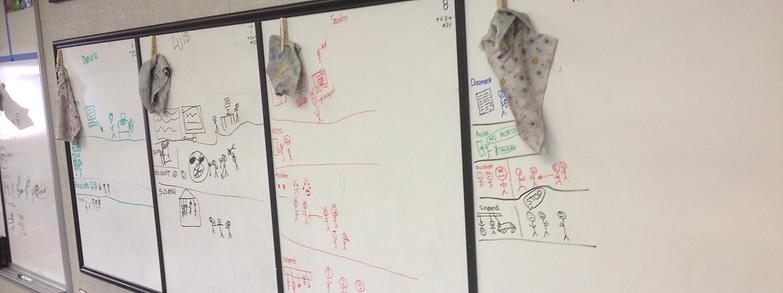
Gallery
Learning
Classroom Glimpse

Come with us as we sit in on a traditional lesson in a traditional classroom. The lesson is led by a very effective teacher, Mrs. Jones, who gets great results from her students, but the teaching techniques are limited because of the physical room environment (students sitting at desks while the teacher stands mostly in the front of the room at the board.)
MRS. JONES: On your desks you have a piece of paper. I’m going to give you a math problem, and you will do it, first, by yourself, and then you will share with a neighbor.
I want you to have something written down to show how you solved it. Here is today’s problem (reading from chart paper): “Mike says you helped him distinguish between area and perimeter. He says that in this square, which is 3 inches in length and 3 inches in height, has an area of 9 square inches. His friend Anna says it’s 12 inches. Can you tell me who you agree with, Mike or Anna? On your paper explain why, prove it.” So is Mike correct or is Anna? You don’t need to copy the question; you can just show your thinking.
(The teacher moves about the room as the students work alone and then in pairs to solve the problem. She intervenes as she sees fit.)
ASHLEY: I’m a little confused. I don’t know what to write.
MRS. JONES: Mike thinks the area is 9 inches squared. Anna thinks it’s 12 inches. Try drawing a picture to tell me what you know.
ASHLEY: I feel like this one, cause like, I agree with Mike, because...
MRS. JONES: Can you prove it? Can you show it in a picture?
ASHLEY: Yeah.
MRS. JONES: Good. And when you’re ready, you can go ahead and share with your partner, which one you think is correct.
MRS. JONES: So why don’t you explain what you did?
TAYLOR: Um, to the …
MRS. JONES: Can you prove it in the picture? Which part of the picture is the area?
TAYLOR: The length times width?
MRS. JONES: Which part of the picture is that?
TAYLOR: Inside.
MRS. JONES: Right there? The inside. So can you show me the 9 inches squared? Can you actually show me that in the picture?
MRS. JONES (To Blake): There are 9 squares inside. Make sure you share that. That’s wonderful! Be sure to share that. So now who do you agree with?
BLAKE: Mike.
MRS. JONES: Why?
(Mrs. Jones continues these types of teacher-student conversations as she moves from student to student.)
MRS. JONES (To the class): Who can come up to the board and show us what you came up with? (Teacher calls up Mollie and Jordan.)
MRS. JONES: What did Mike do?
JORDAN: It’s the area. And the total of it is 9 sided. Which is the area. ‘Cause 3, which is the length, and 3, which is the width. You multiply those two, and it’s 9.
MRS. JONES: Do you agree?
MOLLIE: Yes.
MRS. JONES: Yeah? So what’s inside? What’s actually inside that square? What do you see?
MOLLIE: The area?
MRS. JONES: And what is the area?
MOLLIE: 9.
MRS. JONES: 9. So what do you actually see? 9 what? What are you actually seeing?
JORDAN: 9 boxes.
MRS. JONES: 9… boxes? Can anyone tell me…
TAYLOR: Squares?
MRS. JONES: Squares, yeah. Blake?
BLAKE: I drew 3, ‘cause I made 3 columns and 3 rows.
MRS. JONES: Ah. 3 columns and 3 rows. Why?
BLAKE: Because there are 3 inches on the width and 3 inches on the length.
MRS. JONES: Okay, so we have 3 inches on the width and 3 inches on the length. Okay. And then, earlier, you guys said that area’s the space inside. But with Student 6’s picture, what did he use to measure it? Earlier, you guys colored it in. What did he use to measure the area, the space inside. Avery?
AVERY: Inches?
MRS. JONES: In inches? Okay, what kind of inches, though? Lydia?
LYDIA: Square inches.
MRS. JONES: Square inches. So what does that mean when somebody says square inches? What does that mean?
CODY: It’s, 1 inch squared.
MRS. JONES: It’s 1 inch square! Okay, so here, how many square inches do I have? Emily?
EMILY: 9
MRS. JONES: 9! Okay? So what I’d like you to do if you didn’t do it, is draw this picture in there. So we measure area with squares? That’s a really important concept that we want you to think about. So do you guys agree with Mike or Anna?
STUDENTS: Mike.
MRS. JONES: Mike. Okay. Let’s go on to the next problem.
Now let’s visit a Gallery Learning classroom and see the same lesson. This lesson is led by a very effective teacher, Mrs. Warner, who gets great results from her students, but this classroom is lined with whiteboards.
MRS. WARNER: I’m going to give you a math problem, and you will do it, first, by yourself on your boards, and then you will share with a neighbor.
You must show all of your thinking on your board. Here is today’s problem (pointing to the screen where the math problem is projected.) Please read this aloud together.:
CLASS (in unison): Mike says you helped him distinguish between area and perimeter. He says that in this square, which is 3 inches in length and 3 inches in height, has an area of 9 square inches. His friend Anna says it’s 12 inches. Can you tell me who you agree with, Mike or Anna?
MRS. WARNER: On your board explain your thinking. Be sure to draw models and write sentences. Also, clearly state if Mike is correct or if Anna is correct?
(The teacher moves about the perimeter of the room as the students work quietly at their boards. She gives feedback to individual students through hints and questions.)
MRS. WARNER: Explain in writing here why you drew those lines there.
BLAKE: OK.
MRS. WARNER: How about adding some more pictures?
TAYLOR: OK.
MRS. WARNER: Can you prove that? Can you show it in a picture?
MOLLIE: Yeah.
(Students continue working and sit down to read when satisfied with their work.)
MRS. WARNER (When most students are reading silently): Now I would like everyone to trade places with their B neighbor. Read this person’s board carefully and be ready to discuss your thinking. (Silence)
MRS. WARNER: Discuss any differences you see with your B neighbor. Try to come to consensus on the better way to explain this problem. If or when you come to consensus, please wave at me. (Students engage in lively debate while the teacher listens in and prompts students who may get off task. Teacher acknowledges those students who are waving. When a few neighbor teams have waved, she continues.)
MRS. WARNER: Now we will do a gallery walk. Get ready to move in 5… 4… 3… 2… and 1! To your left with feedback. GO!
(Students walk silently around the perimeter of the room and read each other’s boards. They use their marker to write comments and/or correct errors. The teacher spends some time reading boards as well and monitors student engagement.)
MRS. WARNER: Go home!
CLASS: Go home! (All students walk back to their home boards.)
MRS. WARNER: Did you learn anything about this problem from your gallery walk? Take a few minutes to make changes to your board so that your current thinking is clear. (Teacher waits and watches.) Now share your thinking with your A neighbor. (Teacher listens to conversations and reads boards, taking note of the class consensus as well as any prevailing misconceptions.)
MRS. WARNER: Jordan, will you please share your thinking on this problem?
JORDAN: I think that Mike is right. Here I drew a 3 inch by 3 inch square with 9 squares inside of it. Each of my squares is one inch so the area of this square is 9 inches.
MRS. WARNER: Class, what do you think of what you just heard? Who would like to comment?
CODY: Well, Jordan is kinda right. The area is 9 but it’s 9 square inches, not 9 inches because there are 9 square inches covering the shape.
MRS. WARNER: Discuss what you just heard with your B neighbor. (Waits and listens.) Let’s vote between 9 inches, 9 square inches, and something different. How many of you think the answer is 9 inches? (Students raise hands.) How many of you think the answer is 9 square inches? (Hands go up.) How many of you think the answer is something different. (No students raise a hand.) The correct answer is 9 square inches because each unit covering the big square is a square inch. If you don’t have this drawn on your board, please do it now. (The teacher watches to make sure every student shows the square inches, which is quickly and easily done from her vantage point in the center of the room.) So what do you think confused Anna? Turn to your A neighbor and discuss this. If you don’t have that thinking on your board, add it.
Mrs. Warner continues in this manner until all students have demonstrated a clear understanding of the problem on their boards. This lesson took Mrs. Warner over twice as long as Mrs. Jones, but as you can see, all students gained increased mastery over the concept and Mrs. Warner received much more feedback on student progress than did Mrs. Jones. How else did the lesson improve because of Gallery Learning?